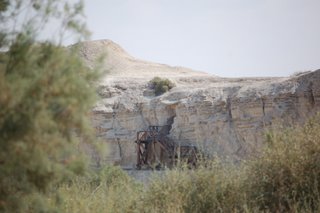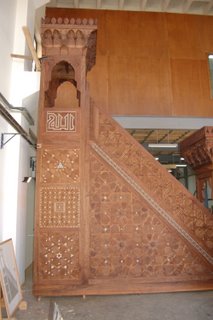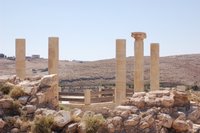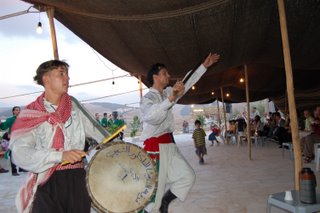On Thursday July 6th, we set out for Bethany [http://whc.unesco.org/en/tentativelists/1556/]and Umm Qais [http://www.romero-jordan.com/about_umm_qeis%20.htm]. This post will focus on Bethany. I will follow with a post on Umm Qais.

We stopped on the road to note that we were at sea level. Which when we are still in the mountainous regions seems kind of strange. The area in the background looks like desert to me, but we are told it is only arid now and that it blooms in the Spring. We are told we will see real desert later during our stay.
As we arrive in the Jordan valley we go through several checkpoints as it is considered a military zone. As we await our passes to go to the site where Jesus is reported to have been  baptized by John the Baptist, this picture is of the city of Jericho. Jericho is the oldest continously inhabited city in existence - the first ancient city was established in approximately 8,000 BC. [http://www.globalsecurity.org/military/world/palestine/jericho.htm]
baptized by John the Baptist, this picture is of the city of Jericho. Jericho is the oldest continously inhabited city in existence - the first ancient city was established in approximately 8,000 BC. [http://www.globalsecurity.org/military/world/palestine/jericho.htm]As we approach the mighty Jordan River, Dr. Peteet warns us to not be disappointed to keep our expectations low.  The following photo shows why she warned us
The following photo shows why she warned us
The site where Jesus is reported to have been baptized by John the Baptist is at an old channel of the Jordan that is now dry. The Jordan's channel varied over time as floods came and went. This site is at located where a spring intersected with the Jordan thus making the water cleaner and more appropriate for baptisms.
The Jordan's channel varied over time as floods came and went. This site is at located where a spring intersected with the Jordan thus making the water cleaner and more appropriate for baptisms.
A church and dock has been built on the Jordan. The dock allows one to splash a little water from the river.  This cowboy from Texas shows how it is done without falling in. The water is considered to be polluted, and we are urged to wash our hands with antibiotic soap.
This cowboy from Texas shows how it is done without falling in. The water is considered to be polluted, and we are urged to wash our hands with antibiotic soap.

There is lovely John the Baptist church that has been built at this Jordan River site.
Immediately across the river is a symbolic sign from Israel.


This is the cave that John the Baptist lived in which I think was fairly recently discovered.
We saw just barely Jerusaleum, but the haze was thick enough that pictures didn't come out.
We left from here and drove toward Umm Qais the next post.
























































